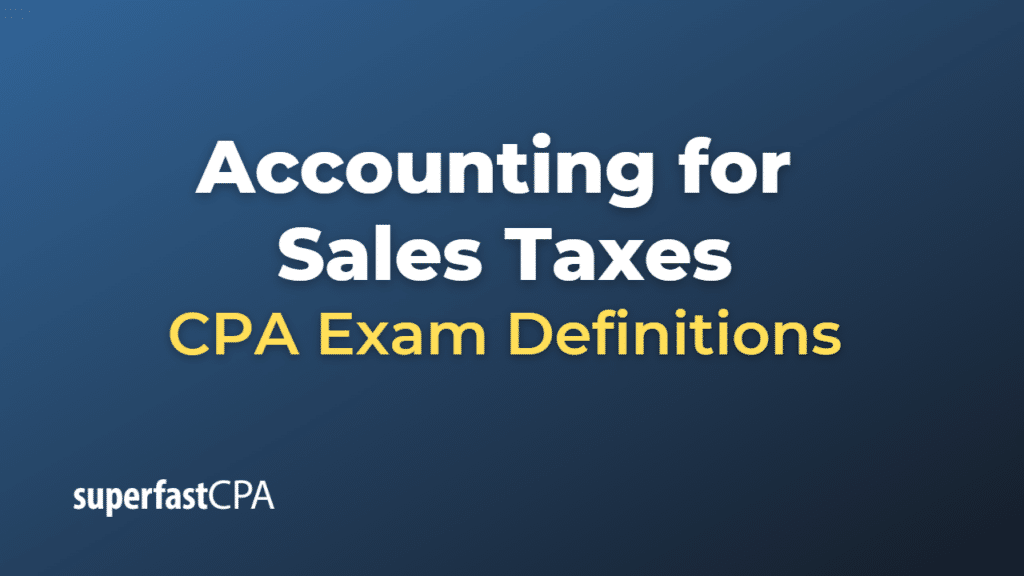Accounting for Sales Taxes
Accounting for sales taxes involves the identification, recognition, measurement, and disclosure of taxes collected by a company on behalf of a government authority when selling goods or services. Sales taxes are indirect taxes imposed by governments on the sale of goods and services, and they are typically calculated as a percentage of the sales price.
Here are the key aspects of accounting for sales taxes:
- Identification: Determine if a transaction is subject to sales tax. This typically involves understanding the applicable tax laws and regulations in the jurisdiction where the company operates.
- Recognition: Sales taxes should be recognized as a liability when they are collected from customers, as they represent amounts payable to the government authority. Sales taxes should not be recognized as revenue since they do not represent income earned by the company.
- Measurement: Sales taxes should be measured as the amount collected from customers, calculated as a percentage of the sales price. The sales tax rate may vary depending on the jurisdiction and the type of goods or services being sold.
- Presentation: Sales taxes should be presented separately from the sales revenue in the financial statements. In the income statement, sales revenue should be reported net of sales taxes. The liability for sales taxes collected should be reported in the balance sheet.
- Payment and reporting: Companies are generally required to remit the collected sales taxes to the government authority within specified periods, such as monthly, quarterly, or annually. Additionally, companies must typically file periodic reports with the government, detailing the sales taxes collected and paid.
- Disclosure: Companies should provide clear and concise information about their accounting policies for sales taxes in the notes to the financial statements. This may include information about the tax rates applicable to the company’s sales and the methods used to account for sales taxes.
By properly accounting for sales taxes, a company provides users of its financial statements with an accurate representation of its financial position and performance, considering the taxes collected on behalf of the government and the company’s obligations to remit those taxes.
Example for Accounting for Sales Taxes
Let’s consider an example of a company accounting for sales taxes.
Example: Company XYZ operates a retail store and sells electronic gadgets. In its jurisdiction, a 5% sales tax applies to the sale of electronic gadgets. In January, Company XYZ sells electronic gadgets worth $100,000, exclusive of sales tax.
Here’s how Company XYZ would account for sales taxes:
Step 1:
Identification: The sale of electronic gadgets is subject to a 5% sales tax in the company’s jurisdiction.
Step 2:
Measurement: Company XYZ calculates the sales tax collected from customers as follows:
| Sales tax: $100,000 × 0.05 = $5,000 |
Step 3:
Recognition: Company XYZ recognizes the sales tax collected as a liability, since it represents an amount payable to the government authority.
| Sales tax payable: $5,000 |
Step 4:
Presentation: Company XYZ presents the sales taxes separately from the sales revenue in the financial statements. In the income statement, sales revenue is reported net of sales taxes.
| Sales revenue (net of sales tax): $100,000 |
The liability for sales taxes collected is reported in the balance sheet.
| Sales tax payable: $5,000 |
Step 5:
Payment and reporting: Company XYZ remits the collected sales taxes of $5,000 to the government authority within the specified period and files the required periodic report detailing the sales taxes collected and paid.
Step 6:
Disclosure: Company XYZ provides information about its accounting policies for sales taxes in the notes to the financial statements, including the applicable tax rate and the methods used to account for sales taxes.
By properly accounting for sales taxes, Company XYZ provides users of its financial statements with an accurate representation of its financial position and performance, considering the taxes collected on behalf of the government and the company’s obligations to remit those taxes.













